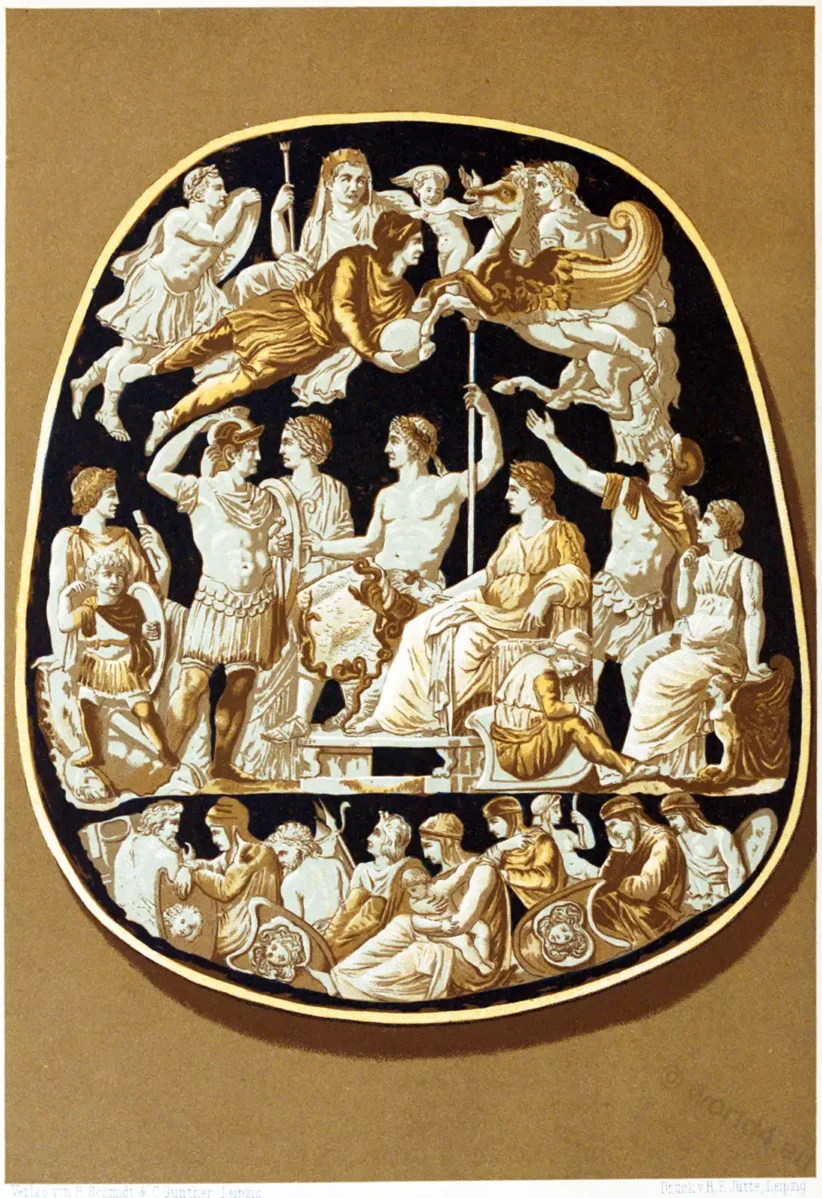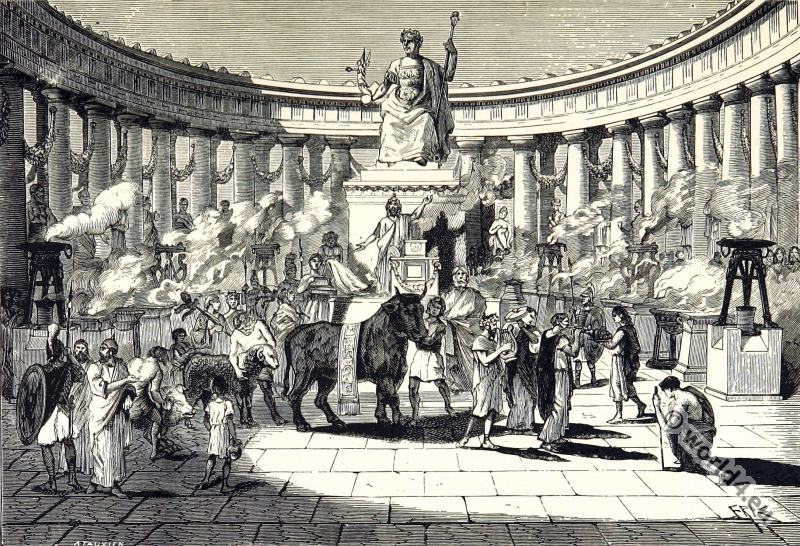Antique cameo, 30 centimetres high, 26 centimetres wide. (Cabinet de France.)
In the upper part: Augustus on Pegasus led by Cupid, Aeneas or Julus, his son, in Phrygian costume, holds the globe in his hand.
Caesar as Pontifex Maximus, his head veiled, wearing a crown of rays, holding the sceptre in his hand, next to Caesar Drusus the Elder, crowned and holding a shield.
In the centre is the family of the Caesars in the year 19: Tiberius, crowned with the laurel, holds the sceptre of Jupiter, with Livia as Ceres at his side. Behind Livia, Drusus the Younger shows his wife Livilla the reception of Augustus by Caesar.
On the other side, Antonia turns towards Germanicus, her son. Behind him are his wife Agrippina and the young Gaius. At the feet of Tiberius the defeated Armenia.
On the lower part, captured Germanic tribes and Orientals symbolising the victories of Germanicus and Drusus.
Apotheosis
Glorification – idealisation – idolisation – deification – exaltation
Apotheosis (from the Greek ἀποθέωσις, from ἀποθεόω/ἀποθεῶ, apotheoo / apotheo, ‘to count among the gods, idolise, deify’; apo ‘idea of intensity’, theo ‘god’, osis ‘formation, drive’) was the name for a ceremony performed by the Romans to admit emperors, empresses or other mortals to the ranks of the gods or heroes. In a broader sense, apotheosis means that a person is showered with exaggerated praise and honours.
The origin of apotheosis almost goes back to that of idolatry (Greek eidolon ‘image, figure’; latreia ‘worship’). This ceremony, which originated in the East and travelled from there to the Greeks and then to the Romans, was based on the opinion of Pythagoras, adopted from the Chaldeans, that virtuous people would be accepted into the class of the gods after their death. Apotheosis was used by the Assyrians, the Persians, the Egyptians, the Greeks and the Romans.
The first apotheosis mentioned is that of Osiris and then that of Belo. All the gods of the Greeks and Latins are much more modern. Xenophon claims that Cyrus was the first to be worshipped as a god during his lifetime.
Cicero mentions the apotheosis of Erechtheus and his sons. Plutarch and Diodorus speak of the apotheosis of Theseus, St Augustine of the apotheosis of Codrus, Origen of the apotheosis of Hercules Thebanus, son of Alcmene and Amphiarus.
Apotheosis or deification passed from the Greeks to the Romans. The Greeks only granted these honours on the basis of an oracle, the Romans on the basis of a senate resolution.
This honour attributed to Romulus was renewed by Augustus in favour of Julius Caesar, who spread the rumour that Venus had carried his soul to the seat of the gods at the time of his assassination.
As a new comet, the Stella Crinita, appeared during the seven days in which the funeral games in honour of Julius Caesar took place, this circumstance lent even more authority to his apotheosis and it was believed that this was the abode of his soul or the soul itself.
Temples were erected to the new god, sacrifices were made to him and his statue was always depicted with a star above his head. It was later discovered that the sun was somewhat pale in the year immediately following his death, which was attributed to the wrath of Apollo, a phenomenon possibly caused by a sunspot.
After Caesar, all other emperors were elevated to the status of gods by the excessive worship of the Romans.
Herodianus, an eyewitness, describes the apotheosis ceremony of the Roman emperors as follows:
When the emperor is dead and is buried with great pomp and splendour, this festival begins, which is a mixture of joy and mourning and is celebrated by the whole city. At the entrance to the imperial palace stands a very high ivory bed covered with gold-woven tapestries and on which stands a wax figure representing the pale and ailing emperor.
On the left side, for a large part of the day, is the Senate in mourning dress, i.e. in white robes, and on the right side the most distinguished Roman matrons without gold pendants or other precious ornaments. This mourning is maintained for seven days, during which many doctors visit the supposedly sick man and assure him each time that he is still alive.
When they announce that the sick Augustus is dead, a few selected young men from the equestrian and senatorial ranks take the supposed corpse and carry it on their backs along the sacred path to the ancient forum, where the Roman magistrates used to dispose of their dignity.
On both sides of the forum there are many steps on which young men and noble girls stand and sing alternately serious and melancholy verses in honour of the deceased.
From there, they carry the bed out of the city to the Field of Mars, where a square catafalque of long beams is erected, leaving a large hollow beneath it. The entire interior of the first catafalque is filled with combustible material, and the exterior is covered with woven tapestries of gold, ivory statues and rich paintings.
Above this catafalque rises another, smaller catafalque, decorated in the same way, with doors that can be opened and used, and above the second catafalque are two more similar, but progressively smaller, rows of catafalques. The entire catafalque resembles a tower or lighthouse used in harbours to illuminate and guide ships in the dark.
Source: Classic picture book by Raimund Oehler. Publisher: Leipzig, H. Schmidt & C. Günther, 1892.

Discover more from World4 Costume Culture History
Subscribe to get the latest posts sent to your email.


